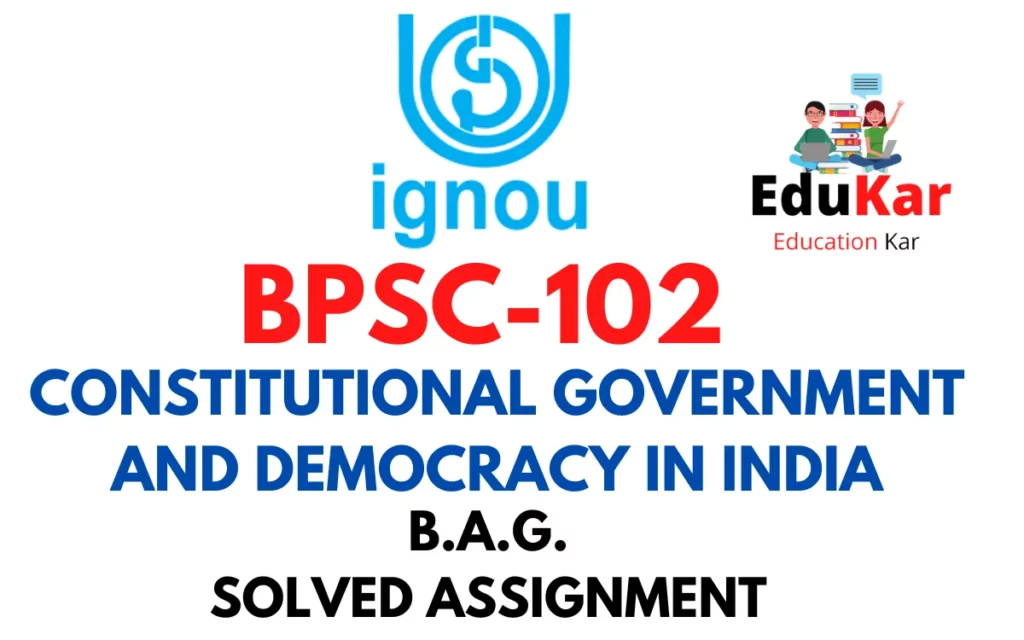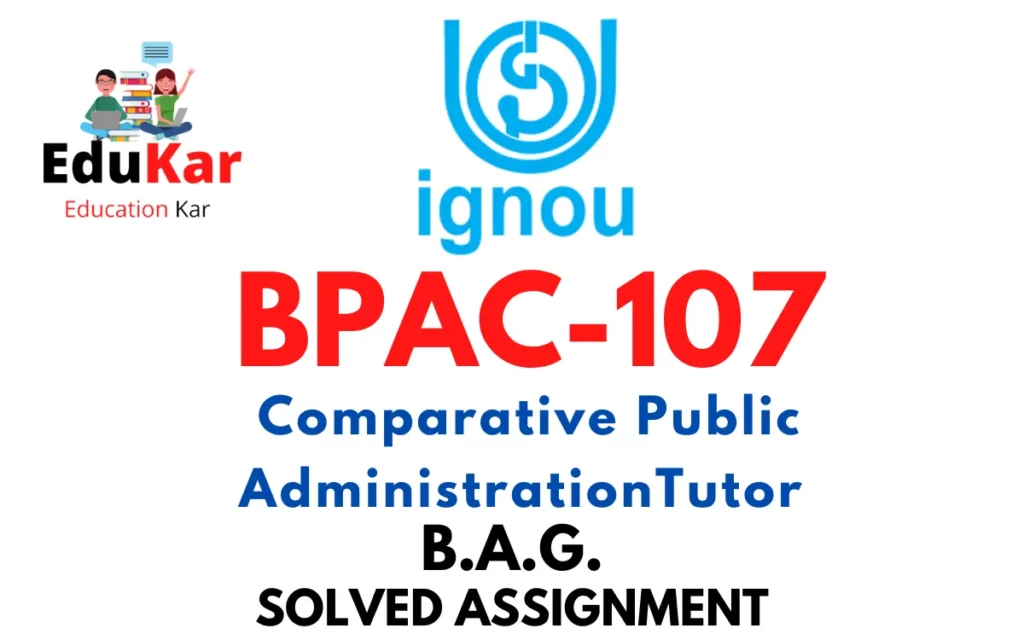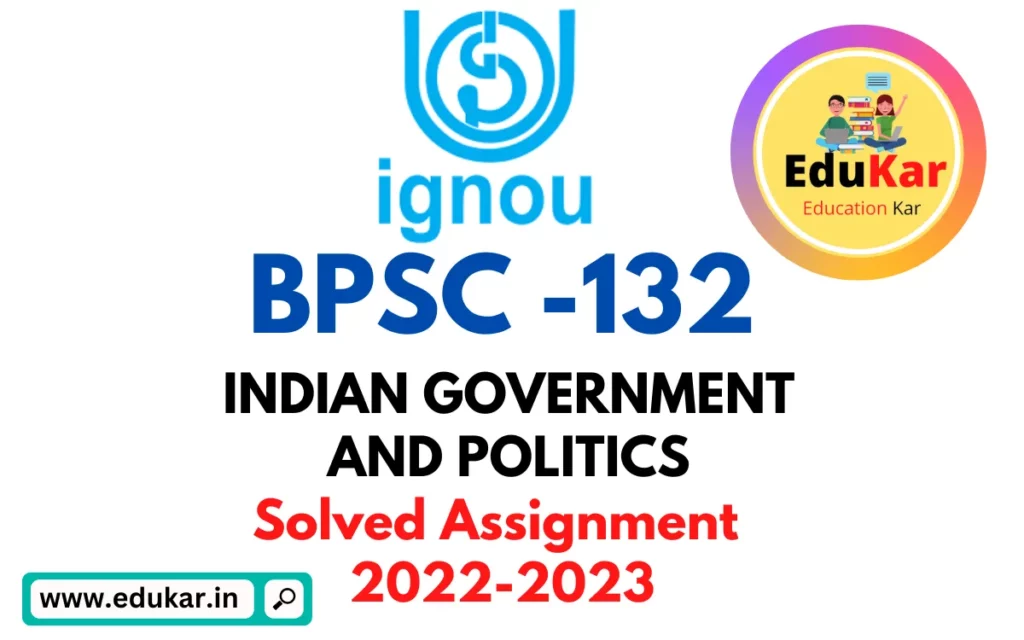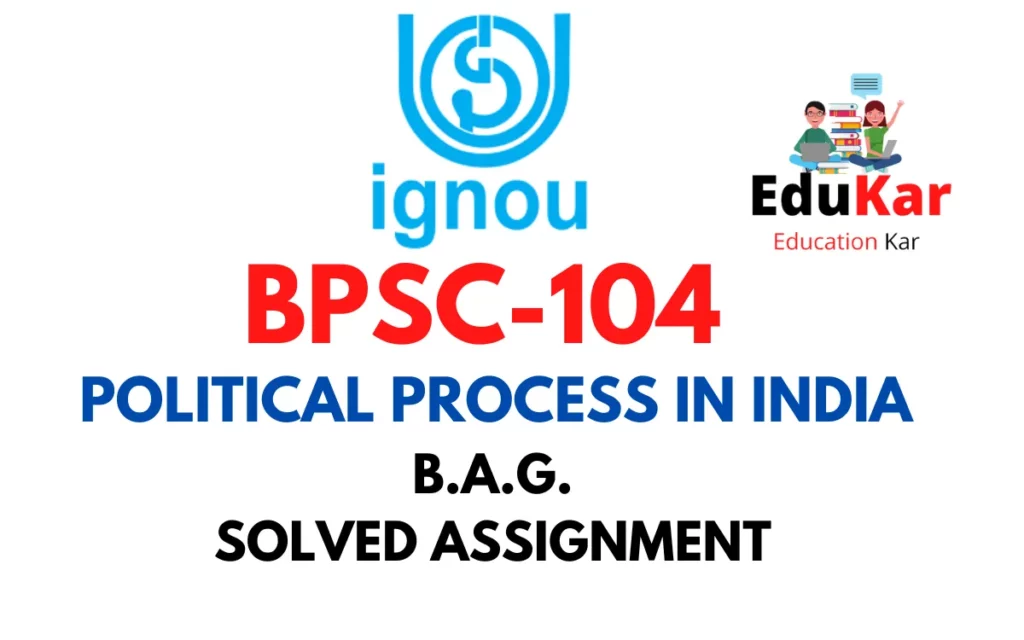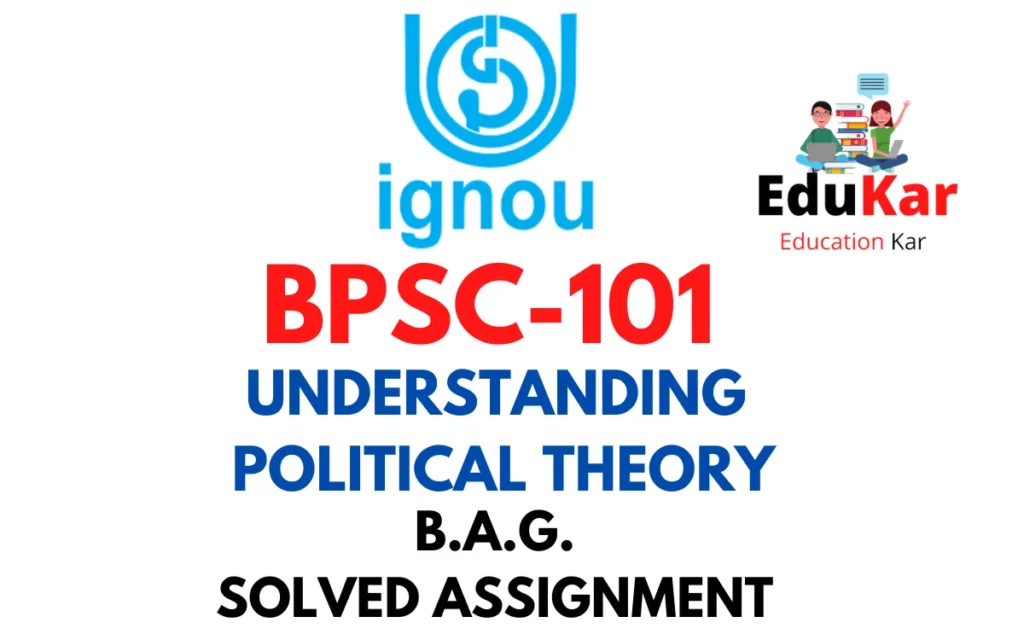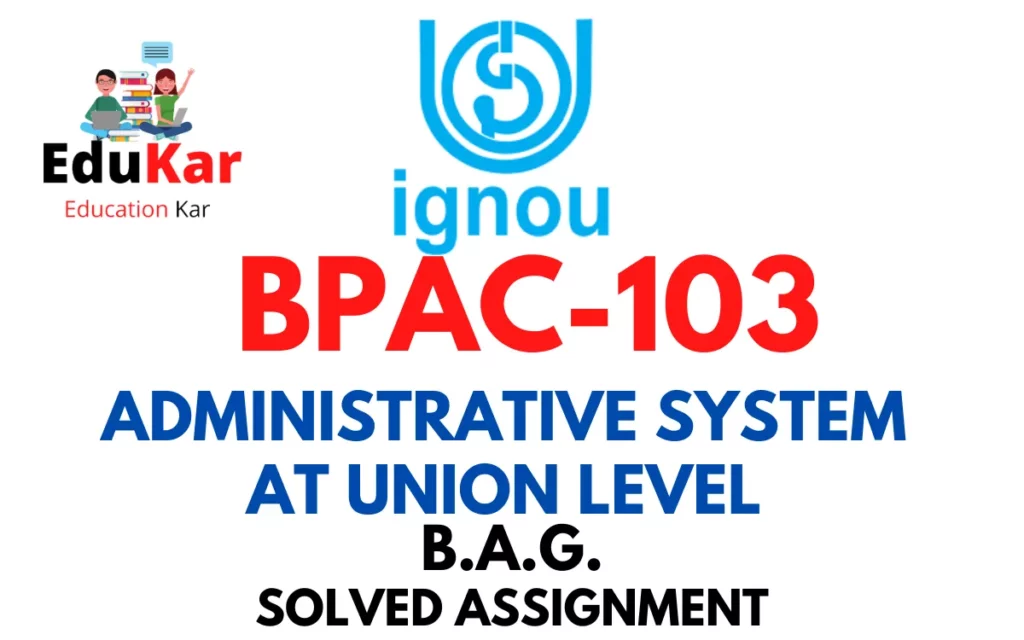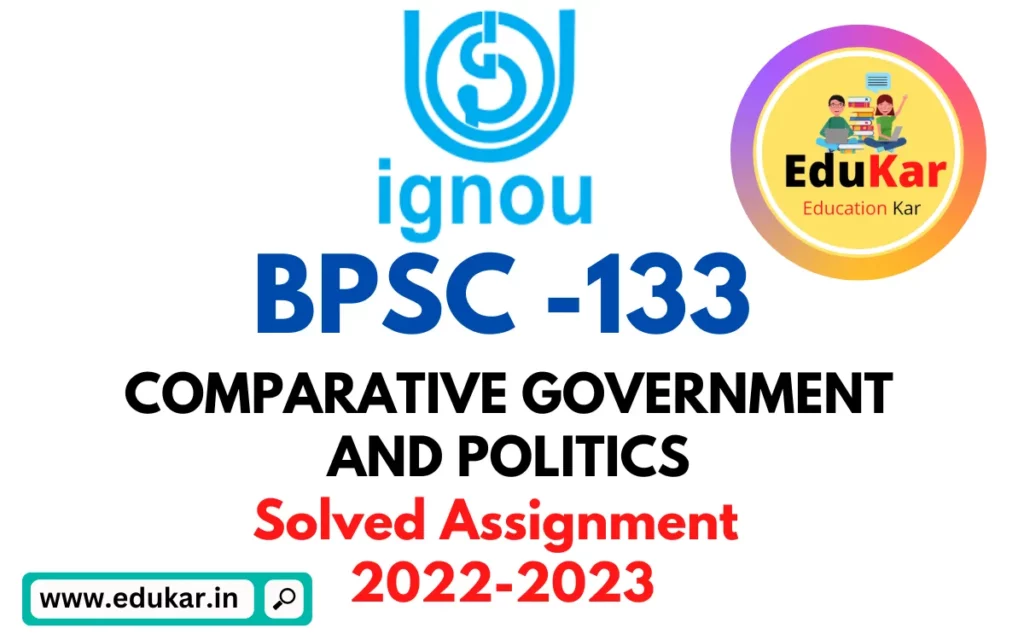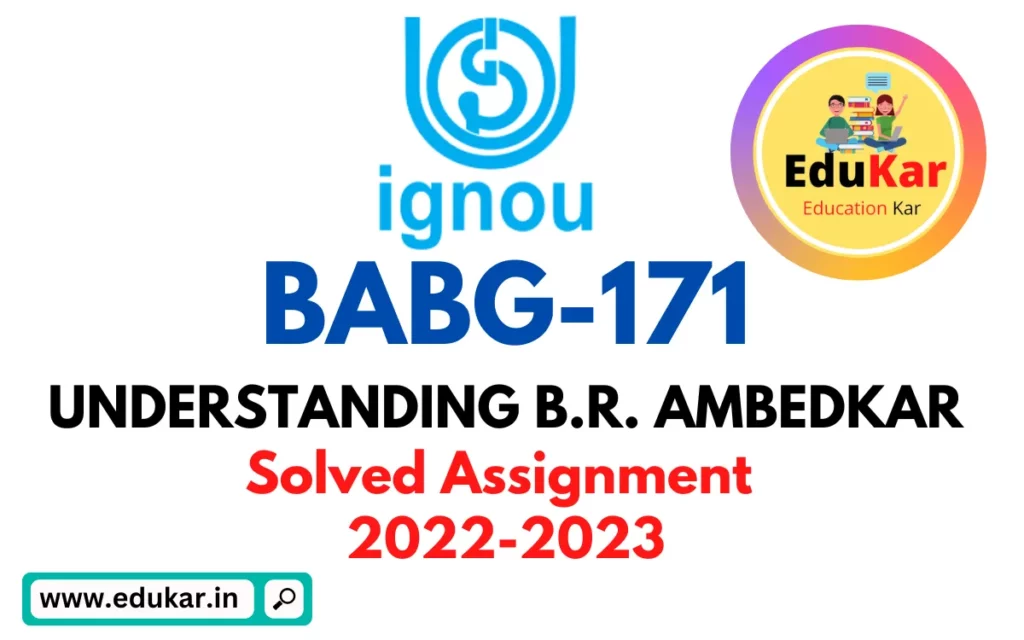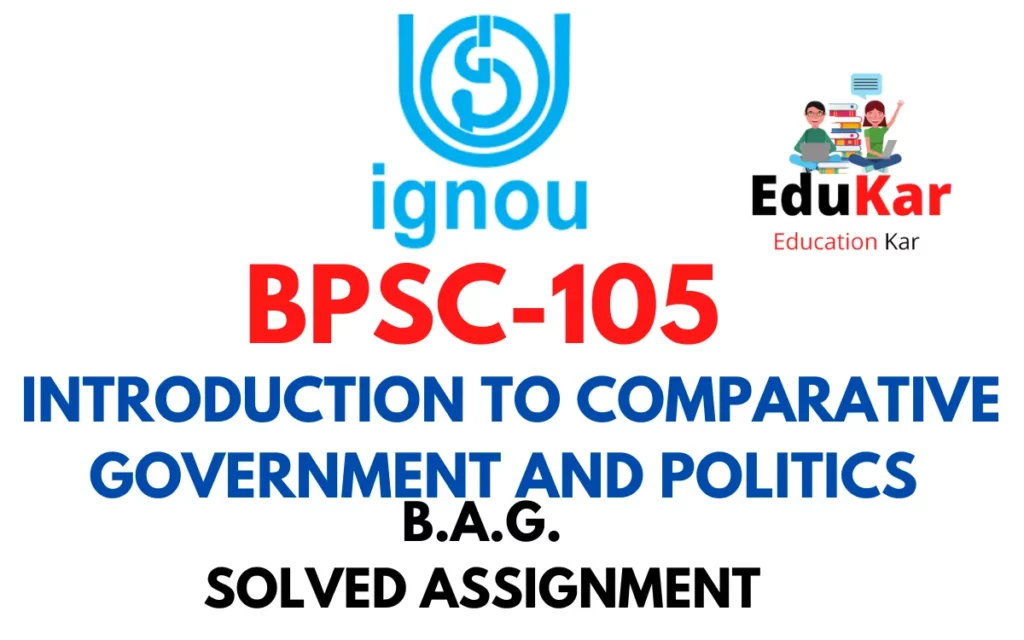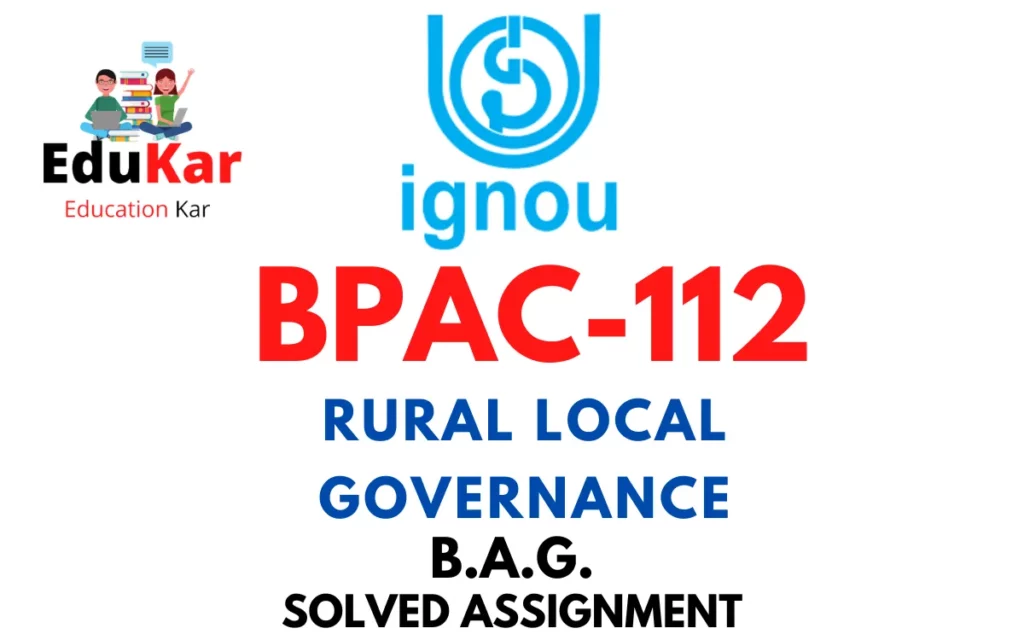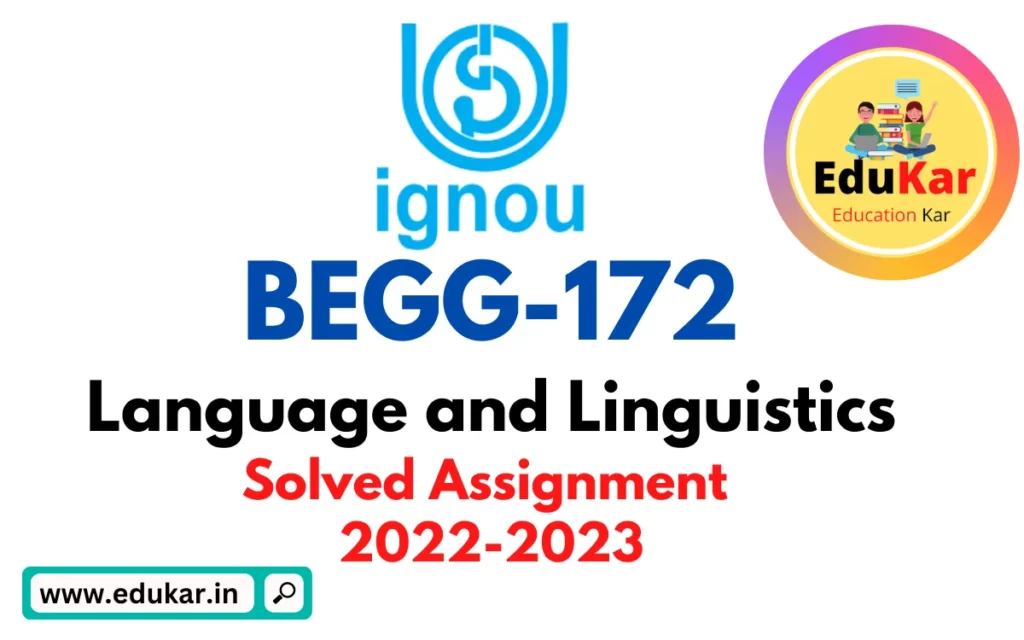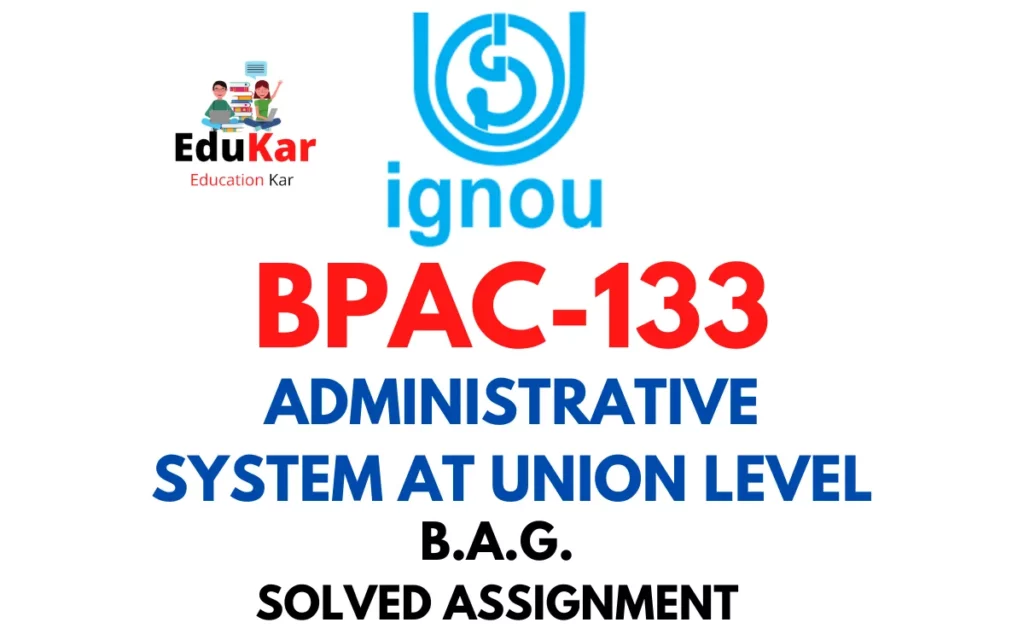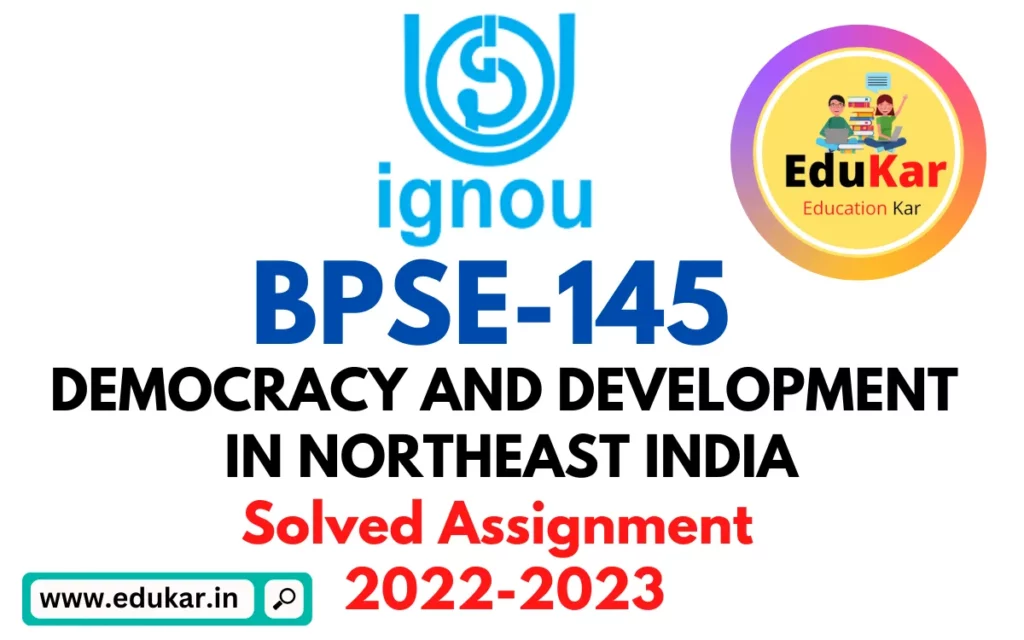Contents
- 1 Assignment I
- 2 Answer the following questions in about 500 words each.
- 3 1. Discussthe constitutional framework of Brazil and Russia.
- 4 2. Examine the administrative reforms undertaken in China.
- 5 Assignment II
- 6 Answer the following questions in about 250 words each.
- 7 3. Highlight the executive authority in South Africa.
- 8 4. Explain the role of bureaucracy in public policy process of Brazil.
- 9 5. Analyse the role of LBSNAA in training of Civil Servants in India.
- 10 Assignment III
- 11 Answer the following questions in about100 words each.
- 12 6. Discuss the audit system in Russia.
- 13 7. Examine the role of developmental local government in South Africa.
- 14 8. Write a note on citizenship in India.
- 15 9. Discuss the process of provincial planning in China.
- 16 10. Enumerate the powers and functions of the State Duma.
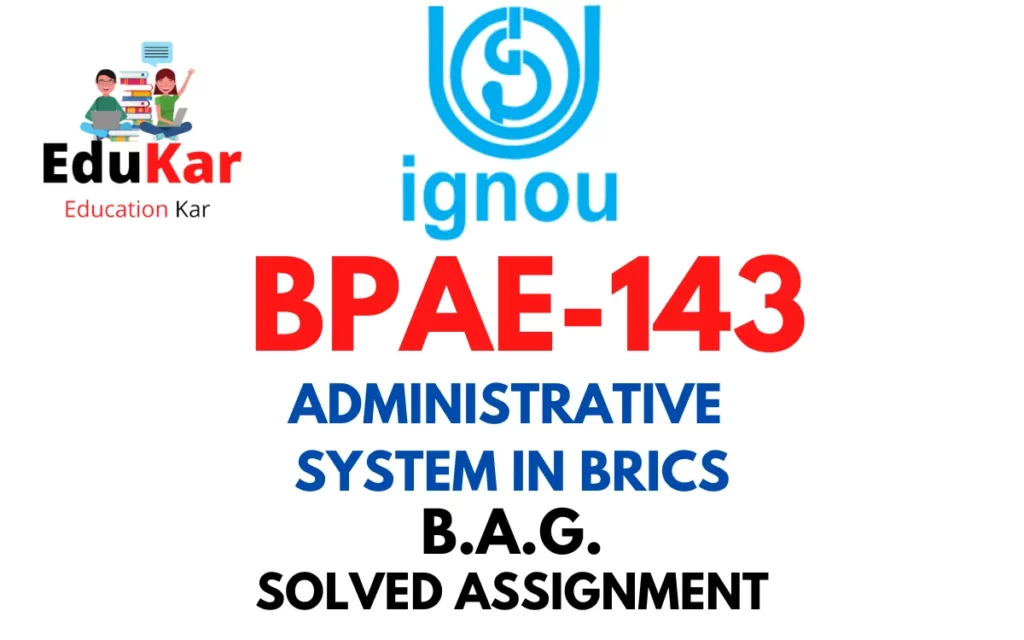
| Title | BPAE-143: IGNOU BAG Solved Assignment 2022-2023 |
| University | IGNOU |
| Degree | Bachelor Degree Programme |
| Course Code | BPAE-143 |
| Course Name | ADMINISTRATIVE SYSTEM IN BRICS |
| Programme Name | Bachelor of Arts (General) |
| Programme Code | BAG |
| Total Marks | 100 |
| Year | 2022-2023 |
| Language | English |
| Assignment Code | ASST/TMA/July 2022 & January 2023 |
| Assignment PDF | Click Here |
| Last Date for Submission of Assignment: | For June Examination: 31st April For December Examination: 30th September |
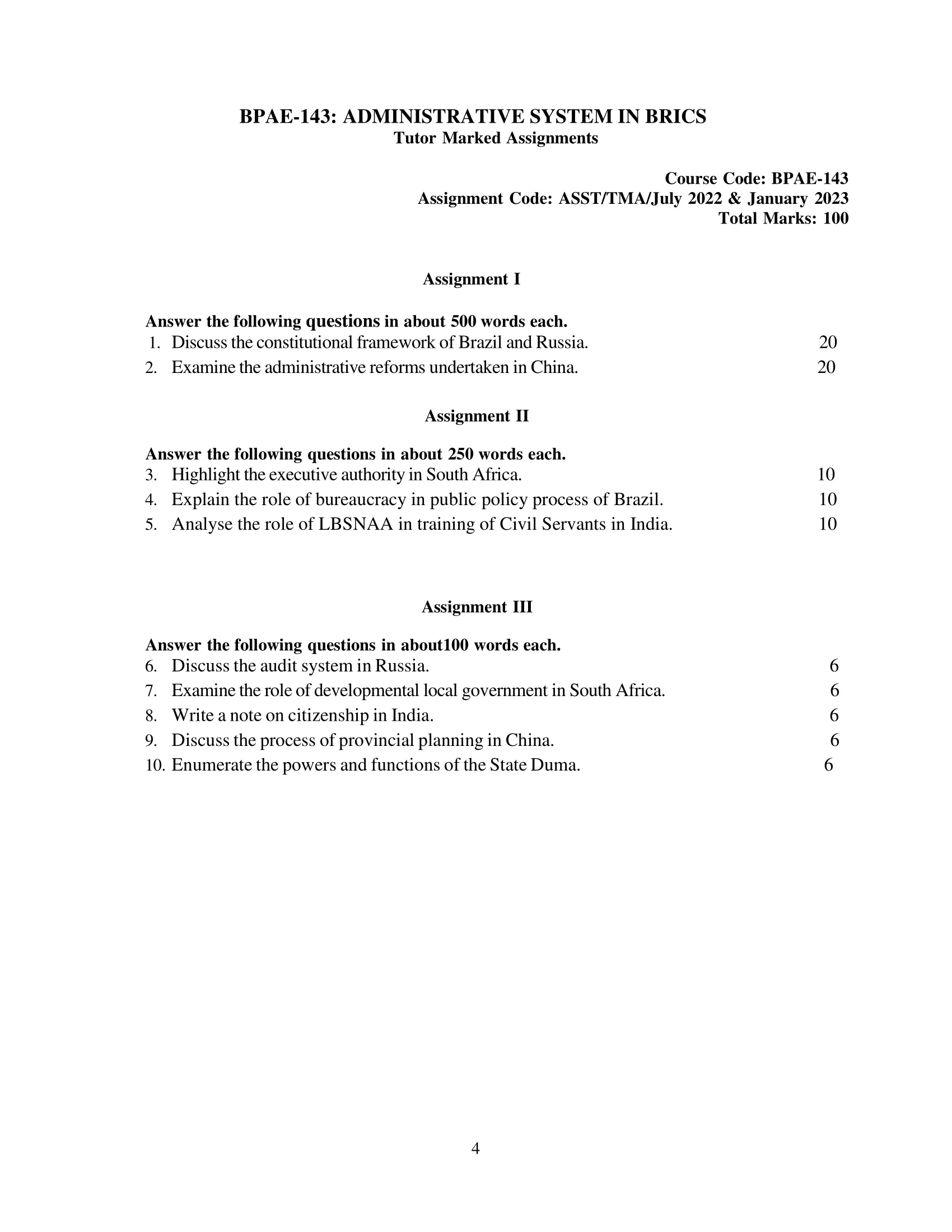
Assignment I
Answer the following questions in about 500 words each.
1. Discussthe constitutional framework of Brazil and Russia.
Ans: Brazil and Russia are two very different countries with distinct political systems and constitutional frameworks. In this response, we will discuss the constitutional framework of both countries in some detail.
Constitutional framework of Brazil:
Brazil’s current constitution was enacted in 1988, and it is the country’s seventh constitution since its independence from Portugal in 1822. The constitution is composed of 250 articles that are divided into nine chapters. The constitution established Brazil as a democratic, federative, and republican state, with a separation of powers among the executive, legislative, and judicial branches.
The legislative branch is composed of the National Congress, which is composed of the Senate and the Chamber of Deputies. The Senate has 81 members, three from each state and the Federal District, and the Chamber of Deputies has 513 members, representing the people. The legislative branch has the power to enact laws, approve budgets, and conduct investigations.
The executive branch is headed by the President of the Republic, who is elected by popular vote for a four-year term. The President is the head of state and government and has the power to appoint and dismiss ministers, sign international treaties, and veto bills. The President is assisted by a Cabinet, which is composed of ministers who are responsible for different areas of government.
The judicial branch is composed of federal and state courts, and the highest court is the Federal Supreme Court, which is composed of 11 justices. The judiciary has the power to interpret the constitution, protect individual rights, and ensure that the other branches of government abide by the constitution.
The constitution of Brazil also guarantees a number of individual rights and freedoms, including the right to life, liberty, and property; freedom of speech and religion; and the right to due process of law. The constitution also guarantees the rights of workers, including the right to form unions and to strike.
Constitutional framework of Russia:
Russia’s current constitution was adopted in 1993 and has been amended several times since then. The constitution established Russia as a federal, democratic, and presidential republic, with a separation of powers among the executive, legislative, and judicial branches.
The legislative branch is composed of the Federal Assembly, which is composed of the State Duma and the Federation Council. The State Duma has 450 members, who are elected for a term of five years. The Federation Council has two representatives from each of Russia’s 85 regions, and its members are appointed by the regional authorities. The legislative branch has the power to enact laws, approve budgets, and conduct investigations.
The executive branch is headed by the President, who is elected by popular vote for a term of six years. The President is the head of state and government and has the power to appoint and dismiss ministers, sign international treaties, and veto bills. The President is assisted by a Cabinet, which is composed of ministers who are responsible for different areas of government.
The judicial branch is composed of federal and regional courts, and the highest court is the Constitutional Court, which is responsible for interpreting the constitution and ensuring that the other branches of government abide by it.
The constitution of Russia also guarantees a number of individual rights and freedoms, including the right to life, liberty, and property; freedom of speech and religion; and the right to due process of law. The constitution also guarantees the rights of workers, including the right to form unions and to strike.
One notable difference between the constitutional frameworks of Brazil and Russia is the method of appointment of the upper house of the legislative branch. In Brazil, the Senate is composed of elected representatives, while in Russia, the Federation Council is composed of representatives appointed by regional authorities. Another difference is the term length for the President, with the President of Brazil serving a four-year term and the President of Russia serving a six-year term.
2. Examine the administrative reforms undertaken in China.
Ans: China has undergone significant administrative reforms since the late 1970s, which have helped transform the country into a major global power. In this response, we will examine the administrative reforms undertaken in China and their impact on the country’s development.
- Decentralization and Local Government Reforms: In the late 1970s, China began a process of decentralization, which involved delegating more power and responsibilities to local governments. This reform allowed local governments to become more responsive to the needs of their citizens and to develop their own economic policies. The central government also began to experiment with various forms of local government, including city and county-level governments.
- Streamlining of Administrative Bureaucracy: China has also focused on streamlining its administrative bureaucracy, reducing the number of government agencies, and reorganizing government functions. One of the most significant reforms was the merging of several ministries in 2018 to form the State Administration for Market Regulation (SAMR), which consolidated responsibilities related to competition, consumer protection, and intellectual property rights.
- Improving Efficiency: The Chinese government has taken several steps to improve the efficiency of its administrative procedures, including the introduction of e-government and the use of big data and artificial intelligence. For example, the “Internet Plus” initiative, launched in 2015, aimed to integrate the internet with traditional industries and government services, reducing administrative procedures and improving efficiency.
- Anti-Corruption Campaign: China has also launched a high-profile anti-corruption campaign since 2012, which has targeted both high-ranking officials and lower-level bureaucrats. This campaign has resulted in the dismissal of more than 1.5 million officials and the prosecution of numerous high-profile individuals, including several members of the Communist Party’s Central Committee. This campaign has been seen as a way to improve government efficiency and reduce corruption.
- Environmental Protection: China has also implemented several administrative reforms to improve environmental protection, including the establishment of the Ministry of Environmental Protection and the National Energy Administration. These agencies have worked to reduce air and water pollution, protect natural resources, and promote sustainable development.
The impact of these reforms has been significant. Decentralization has helped spur economic growth, with local governments playing an increasingly important role in driving development. The streamlining of administrative bureaucracy has helped reduce redundancies and improve efficiency, while the use of e-government and big data has made government services more accessible to citizens. The anti-corruption campaign has helped improve the public perception of the government and reduce corruption, while the focus on environmental protection has helped mitigate the negative impacts of economic growth.
However, some critics argue that these reforms have also led to an increase in government control and a reduction in civil liberties. For example, the government’s emphasis on internet censorship and the use of facial recognition technology for surveillance have raised concerns about privacy and freedom of expression.
Assignment II
Answer the following questions in about 250 words each.
Ans: The executive authority in South Africa is vested in the President, who is the head of state and government. The President is elected by the National Assembly, which is the lower house of the Parliament, and serves a term of five years. The President is assisted in the exercise of his or her executive functions by the Deputy President and Cabinet Ministers.
The President is responsible for the overall governance of the country and is accountable to the National Assembly. The President has the power to appoint and dismiss Cabinet Ministers, who are responsible for the various portfolios of the government. The Cabinet Ministers are collectively responsible to the President and are accountable to the National Assembly.
The President has the power to declare a state of emergency, which enables him or her to take extraordinary measures to maintain law and order. The President can also declare war and make peace, negotiate and sign international treaties, and appoint ambassadors and high commissioners. The President also has the power to grant pardons and reprieves, as well as to commute and remit sentences.
In addition to the powers vested in the President, the Constitution of South Africa also provides for a number of independent institutions that are designed to safeguard democracy and protect the rights of citizens. These include the Public Protector, the Auditor-General, and the Electoral Commission.
4. Explain the role of bureaucracy in public policy process of Brazil.
Ans: Bureaucracy plays an important role in the public policy process in Brazil. Brazil is a large and complex country with a diverse population, and the bureaucracy serves as a key mechanism for implementing and enforcing public policies.
The Brazilian bureaucracy is composed of a large number of federal, state, and municipal agencies, with different levels of authority and responsibility. These agencies are staffed by career civil servants who are selected through a competitive process and are expected to be politically neutral and competent.
The role of the bureaucracy in the public policy process in Brazil starts with the formulation of policies. Bureaucrats participate in the development of policy proposals, providing technical expertise and analysis to policymakers. Once a policy is adopted, the bureaucracy is responsible for developing implementation plans and overseeing the implementation process. This includes developing regulations, allocating resources, and coordinating with other agencies and stakeholders.
Bureaucrats are also responsible for monitoring and evaluating the impact of public policies. They collect data and assess the effectiveness of policies in achieving their intended goals. This information is used to inform policymakers and to make necessary adjustments to policies.
In addition, the Brazilian bureaucracy is responsible for enforcing public policies. Bureaucrats have the authority to investigate violations of regulations and laws, and to take legal action against individuals and organizations that fail to comply with them.
While the bureaucracy plays an important role in the public policy process in Brazil, there are also challenges that must be addressed. One of the most significant challenges is corruption, which can undermine the effectiveness of public policies and erode public trust in the government. In recent years, the Brazilian government has taken steps to address corruption, including increasing transparency and strengthening oversight mechanisms.
Overall, the role of bureaucracy in the public policy process in Brazil is to ensure that policies are developed, implemented, and enforced in a way that is effective, efficient, and responsive to the needs of the people.
5. Analyse the role of LBSNAA in training of Civil Servants in India.
Ans: The Lal Bahadur Shastri National Academy of Administration (LBSNAA) is the premier training institute for civil servants in India. It was established in 1959 and is located in Mussoorie, Uttarakhand. The academy is responsible for the training of newly recruited civil servants as well as in-service training for experienced civil servants.
The role of LBSNAA in the training of civil servants in India is crucial in shaping the future leaders of the country. The academy offers a wide range of courses and training programs aimed at developing the knowledge, skills, and attitudes required for effective public service. These training programs cover a wide range of areas including public policy, governance, law, economics, social development, and management.
One of the key roles of LBSNAA is to develop a shared understanding among civil servants of the values and principles that underpin the Indian Constitution and the democratic system of governance. This includes developing an appreciation of the importance of transparency, accountability, and ethical behavior in public service.
LBSNAA also plays a critical role in developing the leadership and management skills of civil servants. Through its training programs, the academy aims to equip civil servants with the knowledge and skills required to manage complex public policy challenges, lead teams, and develop effective partnerships with stakeholders.
In addition, LBSNAA provides a platform for civil servants to learn from each other and share their experiences. The academy brings together civil servants from different parts of the country and from different fields of work, providing a forum for them to exchange ideas and learn from each other’s experiences.
Assignment III
Answer the following questions in about100 words each.
6. Discuss the audit system in Russia.
Ans: The audit system in Russia is primarily focused on ensuring compliance with laws and regulations, promoting transparency and accountability in public financial management, and preventing corruption. The audit system in Russia is led by the Accounts Chamber, which is an independent federal agency responsible for conducting financial and compliance audits of all levels of government, including federal, regional, and municipal authorities. The Accounts Chamber also conducts audits of state-owned enterprises and organizations that receive public funding. The audit reports are submitted to the President, the government, and the relevant legislative bodies, and are made available to the public. The objective of the audit system is to improve the efficiency and effectiveness of public spending, to ensure that public funds are used for their intended purposes, and to prevent fraud and corruption.
7. Examine the role of developmental local government in South Africa.
Ans: The concept of developmental local government (DLG) is a central feature of South Africa’s post-apartheid governance system. It refers to the idea that local government should be more than just a provider of basic services, but should also be an agent of social and economic development.
The role of DLG in South Africa is to promote inclusive growth and development by creating an enabling environment for social and economic transformation at the local level. This involves empowering communities and building their capacity to participate in decision-making processes, as well as facilitating the delivery of basic services and infrastructure to meet the needs of the people.
DLG is based on the idea that local government is the most appropriate level of government to drive social and economic development, as it is closest to the people and has a deep understanding of their needs and aspirations. The role of local government is to work in partnership with other stakeholders, including civil society organizations, private sector entities, and other levels of government, to achieve common goals.
DLG also seeks to address the inequalities and disparities that exist within and between municipalities, by focusing on the needs of marginalized communities and promoting inclusive development. This is achieved through a range of mechanisms, including participatory planning and budgeting, community-driven development, and social and economic infrastructure development.
8. Write a note on citizenship in India.
Ans: Citizenship in India is governed by the Citizenship Act of 1955 and subsequent amendments. The Act defines the criteria for acquiring, registering, and renouncing citizenship, and sets out the rights and obligations of Indian citizens.
Under the Citizenship Act, a person may acquire Indian citizenship by birth, descent, registration, or naturalization. Birth citizenship is granted to a person born in India if one or both of their parents are Indian citizens, or if the person is born to stateless parents or parents of unknown nationality. Descent citizenship is granted to a person born outside of India if one or both of their parents are Indian citizens. Registration and naturalization are other methods of acquiring Indian citizenship, and are subject to certain conditions and criteria.
Indian citizens enjoy a range of rights, including the right to vote, the right to hold public office, the right to freedom of speech and expression, the right to equality before the law, and the right to religious freedom. Indian citizens also have certain obligations, including the obligation to pay taxes, the obligation to obey the law, and the obligation to defend the country in times of national emergency.
However, citizenship in India has been a controversial issue in recent years, particularly with the introduction of the Citizenship Amendment Act (CAA) in 2019. The CAA seeks to provide citizenship to non-Muslim migrants from Pakistan, Afghanistan, and Bangladesh who came to India before December 31, 2014. The Act has been criticized by some as being discriminatory and unconstitutional, as it excludes Muslim migrants and violates the secular principles of the Indian Constitution.
9. Discuss the process of provincial planning in China.
Ans: Provincial planning in China is a key component of the country’s overall economic development strategy. The process of provincial planning involves several steps, which are outlined below:
- Establishing Objectives: The first step in provincial planning is to establish development objectives, which are aligned with the country’s overall economic goals. These objectives are typically set by the central government and communicated to provincial governments.
- Formulating Plans: Based on the development objectives, provincial governments then formulate plans that outline specific policies and strategies to achieve those objectives. These plans typically cover a range of areas, including economic development, infrastructure, social welfare, and environmental protection.
- Stakeholder Consultation: During the planning process, provincial governments typically consult with a range of stakeholders, including local communities, businesses, and government agencies. This helps to ensure that the plans are realistic and feasible, and that they take into account local conditions and needs.
- Implementation: Once the plans are finalized, provincial governments begin implementing them. This involves allocating resources, coordinating with other government agencies, and monitoring progress.
- Evaluation and Adjustment: As the plans are implemented, provincial governments regularly evaluate progress and make adjustments as needed. This helps to ensure that the plans remain on track and that they are achieving the desired outcomes.
The process of provincial planning in China is tightly integrated with the country’s overall economic development strategy, which is focused on promoting sustainable growth, improving living standards, and reducing regional disparities. The central government plays a key role in guiding and coordinating provincial planning efforts, while also providing funding and support to help implement the plans.
10. Enumerate the powers and functions of the State Duma.
Ans: The State Duma is the lower house of the Federal Assembly of Russia and has the following powers and functions:
- Legislative Power: The State Duma has the power to pass laws, which are then sent to the upper house, the Federation Council, for approval.
- Approval of Budget: The State Duma has the power to approve the federal budget.
- Confirmation of Appointments: The State Duma has the power to confirm or reject the President’s nominees for government positions.
- Oversight: The State Duma has the power to oversee the work of the government, including conducting inquiries and investigations.
- Impeachment: The State Duma has the power to impeach the President or other high-ranking officials for crimes or other serious misconduct.
- Ratification of International Treaties: The State Duma has the power to ratify or reject international treaties.
How to Download BPAE-143 Solved Assignment?
You can download it from the www.edukar.in, they have a big database for all the IGNOU solved assignments.
Is the BPAE-143 Solved Assignment Free?
Yes this is absolutely free to download the solved assignment from www.edukar.in
What is the last submission date for BPAE-143 Solved Assignment?
For June Examination: 31st April, For December Examination: 30th October


